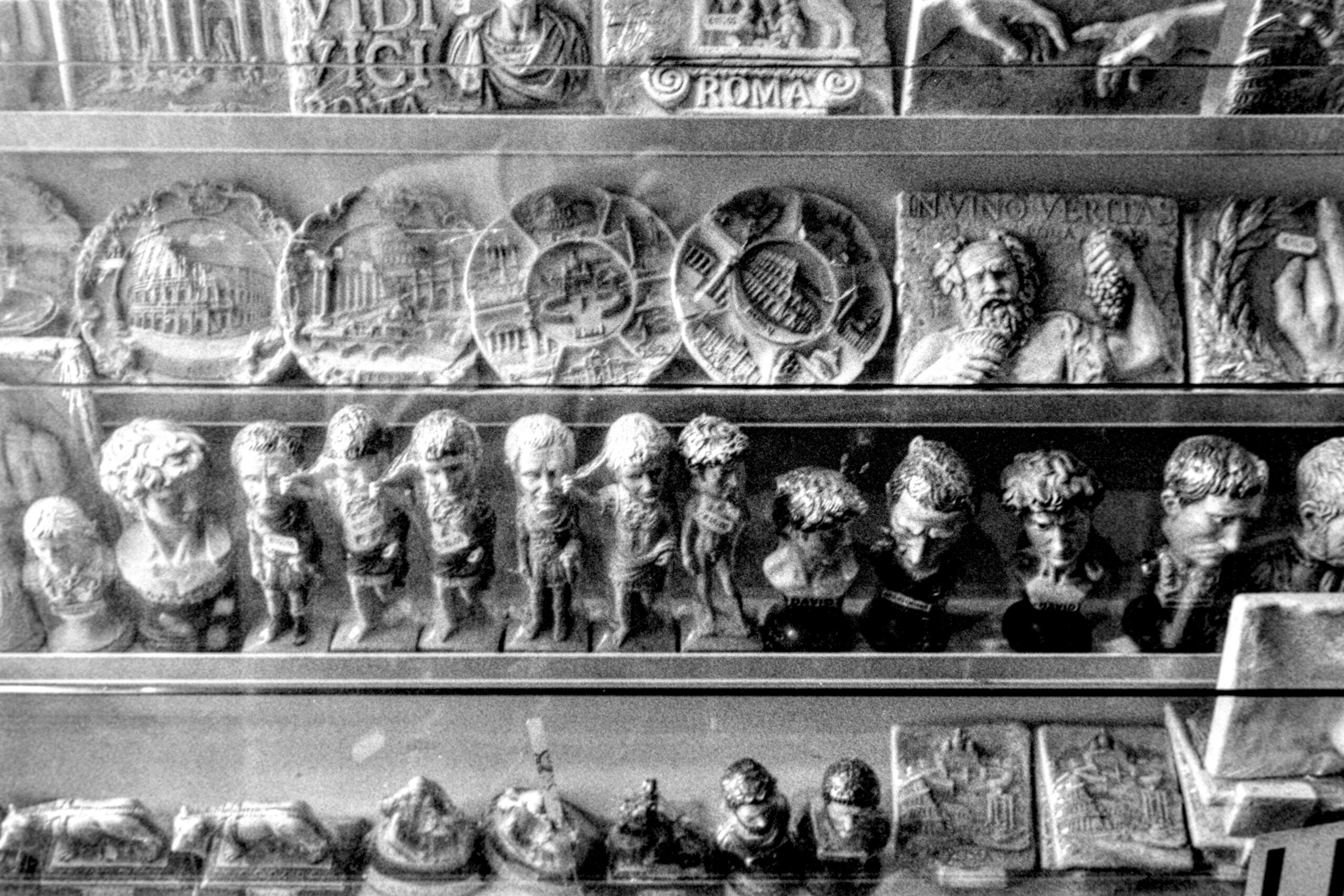Rome’s souvenir shops are full of busts, plaques and other artefacts mixing the sacre and the profane —and sometimes even things that have nothing to do with the Eternal City. This make it challenging for a tourist to actually understand what he is looking at —and googling for information is not a common practice among that kind of visitors who, as Aldous Huxely brilliantly pointed out, travel without knowing exactly why they are visiting a certain place or another. Nevertheless, these souvenir displays offer an insight into some of the most fascinating aspects of Rome’s culture and history.
On the top shelf, a plaque shows Latin inscription “IN VINO VERITAS” featuring a figure holding grapes.
The claim — still nowadays effective as a marketing stunt for wine and spirit makers — means ‘in wine lies the truth’. Clearly, our ancestors already knew how to build a truth machine without the need for polygraphs, sensors and AI. Just imagine how this would have changed the CIA preliminary tests or the scripts of the countless high-tech motion pictures and TV series relying upon various tricks to elicit the truth out of a suspect… surely less drama, but much more fun. The person holding the grapes symbolises Bacchus, the Roman god of wine. Contrary to his Greek counterpart, Dionysus, Bacchus was a hedonist who loved parties and freedom.
The middle shelf displays a series of busts depicting some of the most notable Roman emperors.
Among those that can be recognised is Julius Caesar, whose military campaigns shaped Europe and gave Paris its name: Id est oppidum Parisiorum, quod positum est in insula fluminis Sequanae. He was also the one who uttered the iconic phrase ‘Veni, vidi, vici’ (‘I arrived, I saw, I conquered’), which was the precursor to the idea of the blitzkrieg and a display of might, depicted in the plaque on the top shelf.
Octavian Augustus was the ruthless creator of the Pax Augustea, a period of rule based on the idea that the people deserved tranquillitas, not libertas — peace, not freedom. This geopolitical concept is still cultivated in some academic circles specialising in international relations and think tanks.
Marcus Aurelius was a complex figure. A scholar of Stoicism, his writings remain an important source for studying this philosophy. Despite some extreme interpretations of life and death, they provide an alternative way of life to our hyper-aggressive and hyper-competitive zeitgeist. Among the laws he passed were the prohibition of torture for slaves in cases where no other evidence was found, the establishment of a public registry of births, and the right of a slave to buy back their freedom.
The English and Scottish people mainly know Emperor Hadrian for the military fortress he built: Hadrian’s Wall. Although the wall, which is 118 km long, is no longer the actual border between England and Scotland, it is still sometimes referred to as such. Like Marcus Aurelius, he believed that slaves should have some rights. Hadrian is also considered to have created the civil service, including the advocatus fisci — a sort of lawyer whose duty was to defend the Empire in legal claims concerning taxes.
Emperor Trajan was both a soldier and a developer. During his reign, the empire expanded to its maximum extent and Rome was transformed through large-scale urban development. However, he should mainly be remembered for his Institutio Alimentaria, a sort of ‘executive order’ through which he used his personal wealth to fund an initiative to feed Italian children affected by famine. Even if Traian had only achieved the Institutio Alimentaria, it would have made him worthy of remembrance.
The bottom shelf features miniature replicas of the Capitoline Wolf (Lupa Capitolina) nursing Romulus and Remus. This represents the foundational myth upon which Rome was built. Romulus and Remus were the sons of Rea Silvia. As a Vestal of regal origins, she was not permitted to have children. However, she was raped by Mars, the god of war, and gave birth to two children. Rather than having them killed, the babies were abandoned in a chest that floated down the Tiber River, leaving their lives in the hands of fate. Later, a female wolf found them and, rather than killing the newborns, fed them.
As this short account shows, choosing a souvenir in Rome can also be an intellectual experience. After all, you can select one according to your personal attitudes towards life, the universe, and everything (sorry, that was Douglas Adams and was supposd to be used in another post).
Share this post:









Comments
Martin on One Shot Story – What Souvenirs Say About Rome (and Your Attitude Toward Life)
Comment posted: 06/08/2025
Comment posted: 06/08/2025
Geoff Chaplin on One Shot Story – What Souvenirs Say About Rome (and Your Attitude Toward Life)
Comment posted: 06/08/2025
Japanese souvenirs are very different. It's the packaging that matters - multiple layers of wrapping paper neatly taped and tied withe decorative string. Contents are irrelevant, any old crap, as long as the packaging is nice.